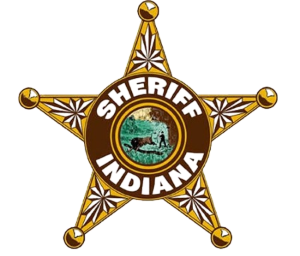 Sheriff Henley James
Sheriff Henley James
Sheriff James was born on May 5, 1816 and died on January 8, 1886
Sheriff James served Grant County as Sheriff from 1839 to 1842
Henley James is an honorable man who served as the Sheriff of Grant County. Not only was Henley James the Sheriff bought he also served as a Judge in the county. The following is several short biographies on his magnificent life.
Judge
Henley James October 3, 1850. to serve seven years from August 8. 1845, to fill out unexpired term of Caleb Smith.
The gentleman whose name introduces this sketch was born in Wayne County, Indiana, July 5, 1871. His grandfather, John James, was a native of Virginia, but early immigrated to North Carolina, where he died many years ago. His son, John James, Jr., father of our subject, was born in North Carolina December 4, 1773. He came to Indiana in 1814 and settled in Wayne County and later moved to Randolph County, where he lived until 1833. He came to Grant County in the latter year and settled on Deer Creek in Center Township, where he lived a number of years. He died where the widow of Henley James now lives, on the 21st of December 1855. His wife, Mary (Snead) James, was the daughter of Henley Snead, a native of Virginia, and an early settler of North Carolina. Mrs. James was born in the latter state in 1776, and died in Grant County, Indiana, on the 5th of March 1869. John and Mary James raised a family of ten children, the subject of this sketch being the ninth in number. Henley James spent the first sixteen years of his life in Wayne and Randolph counties, came with his parents to Grant County and seven years later was elected Sheriff. He grew to manhood on a farm and on reaching his majority began reading law, but was never admitted to the bar, refusing to take the oath required before obtaining license. He early untied with the Christian Church and afterward entered the ministry, in the active work of which he was engaged for twenty-five years, preaching in various parts of northern Indiana and elsewhere. He was Associate Judge of Grant County when that office was abolished, and represented the county in the Legislature two terms. He was Master of the State Grange for eight years, and for ten years was a member of the executive committee of the National Grange. He was an active businessman, a courteous Christian gentleman, and lived to see all his children members of the church to which he had belonged for so many years. Mr. James was married November 26, 1840, to Miss Sarah, daughter of Joseph and Lydia (Overman) Holman. Mrs. James was born on the 15th of October 1823, and is still living. Eleven children were born to Mr. and Mrs. James, the following of whom are living, viz: David S.; Emily, wife of Joel R. Davis; Mary, wife of Dr. D. B. Snodgrass; Solomon H.; George; Lydia, wife of E. L. Byrd; Laura, wife of George B. Winchel; and Alice, wife of O. G. Cowgill. Mr. James died on the 8th day of January 1886.
Here is another biography on Henley James
The year 1914 is the century milestone for the immediate ancestry of David S. James in Indiana. The North Carolina family of that name moved to Randolph County, Indiana, in 1814, soon after the smoke of the battle of the Mississinewa had cleared away, opening up the great northwest territory for occupation by the whites. The James family lived in Randolph County until the year "the stars fell," and in 1833 emigrated to grant County. However, the James family "Hoosier schoolmaster' was in Grant county two years before local civil government was established. Mr. David S. James has been the continuous president of the James family organization since its first meeting in 1904. Mr. C. S. James is genealogist and historian of the family, and the family tree is perhaps the most perfect of any in Grant County. The fifth generation of the James children may readily trace their ancestry to the family that gave to Grant County its first schoolmaster, William James. Concerning William James some interesting comment will be found in the first volume of this history. The permanent settlement of the family in 1833 was made near Deer Creek, on land that had been entered by a son of John and Mary (Snead) James. Among the children of John and Mary James was Henley James, who in turn was the father of Davis S. James.
When Henley and Sarah (Holman) James were married on November 26, 1840, they started housekeeping on Lugar Creek, three miles east of of the Grant County Courthouse, where the family lived for many years, and that place will always be known as the James family homestead. Henley James was a progressive, unusually active farmer and citizen, and there is mention of him in the chapter on Civil Government in this work. During war times he represented Grant County in the Indiana Legislature, being elected in 1833, and again in 1865. He was one of the thirty-nine members of the legislature who remained loyal to Indiana's War Governor, Oliver P. Morton, and who adjourned the session in Indianapolis, where southern influence was being exerted, and continued the session in Madison. Henley James was a man who had the courage of his convictions relative to the conduct of the war. While others of the original family lived temporarily in Grant County, and while the family furnished Grant County's first schoolmaster, it was Henley James who became identified with the community and reared a family here. Henley James died January 8, 1886, and his wife passed away October 3, 1896. Of that generation, and surviving both Henley and wife, was Miss Rachel James, who died in this county in 1905. Miss James was an original member of the Octogenarian Club, and although always an invalid, few people were ever endowed with stronger intellect and she remained young in thought and always abreast of the times, commending and condemning twentieth century customs. At her death the James family missed something -it was like the family clock had stopped, as "Aunt Rachel" had always been reckoned with in everything. She had been baptized in the Mississinewa River at Washington Street in 1840, before the stream was spanned with a bridge. When the gas and oil development came to her community, she decried the Continental Sabbath, saying she believed the first day of the week was when man should rest from his labors. Miss James was the last of her family, and in her the "schoolmaster" still lived -her influence was for the right in all things.
The entire James family was endowed with strong characteristics, and though its members have possessed positive natures, they have all been inclined to reading and enlightment, and the present generation are students of all the problems of the day.
Henley James died at sixty-eight, and his wife at seventy-two. Both have led active lives, and they left a family that is still known in the community. Their first child, William, died in infancy. The second, David Snead James, says that a man born September 24, 1843, has crossed the dead line -threescore and ten years, the allotted span of most Grant County citizens, but he still retains an abiding interest in things and expects to be a vital part of life in this county for some years to come. The children who followed him birth are as follows:
- Emily J., who married Joel Davis
- Mrs. Mary J. Snodgrass, wife of Doctor D. B. Snodgrass
- Solomon H. James, who married Louisa Byrd
- George James who married Belle Carll
- Mrs. Lydia J. Byrd, wife of J. L. Byrd
- Mrs. Laura J. Winchell, wife of George B. Winchell
- Mrs. Alice J. Cowgill-Walsh, whose first husband was O. C. Cowgill and her second Max Walsh.
-
On June 7, 1866, at the Hays family homestead in Van Buren Township, David S. James married Weimer Hays, daughter of William and Sarah (Nickum) Hays. Most of their married life has been spent in that neighborhood in which they were married, and Mr. James ahs passed every one of his birthdays in Grant County. The Hays family likewise were among the early settlers of this county. To the marriage of Mr. and Mrs. James have been born children as follows:
- Charles S. James, who married first Docia S. Davis, and second Laura James.
- Miss Mary S. James died in young womanhood.
- Harvey H. James, who married Mary Pearson, has two children by that marriage, Ethel and Earl James, and by his marriage to Lena Sloderbeck, has another daughter, Miss Mary James.
- George N. James
- Mrs. Rosella J. Troyer, wife of Charles Troyer, and their children are Paul and Jennie Troyer.
- John A. James, who married Nellie Leaverton, and their two children are Clyde and Russell James.
- Joseph H. James has been twice married, first to Caroline Brown and second to Mamie Clouser.
Members of the James family were among the early adherents of the Disciples (Christian Church), and D. S. James holds a membership with the Central Christian Church in Marion. While the early James family were Democrats, the Lincoln brand of Republicans actuates the later members. Recently Mr. James lined up with the Progressive cause, and declared he has his ear to the ground, ready for the advance movement which he regards as best for himself and the country. In concluding this brief family sketch we shall refer briefly to a local landmark, whose history should not be forgotten and which has a number of associations with the James family. Many years ago was held a Sunday School picnic in the woods on the Hays farm, part of which is now the D. S. James place. The meeting place was in Van Buren Township at the corner of four townships, Van Buren, Monroe, Center, and Washington -and as it was a union Sunday School picnic, the place was thereafter called Union Grove. The next point in the story was the establishment of a star route post-office, which received the name of Union Grove. However, the post-office was shifted from one farmhouse to the last locality to bear that name was at a considerable distance from the one in which the above mentioned picnic was held. There is a fine oak grove about the James homestead, and were it not for the fact that the name Union Grove has thus become common speculating property, it might well designate this particular farm.


